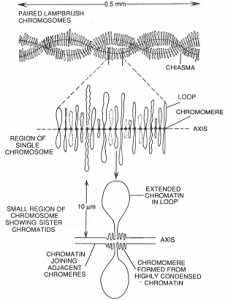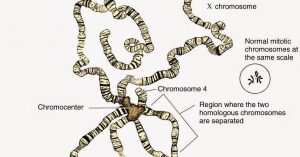Giant chromosomes: Chromosomes which, compared with regular chromosomes, are incredibly large. Any animal cells produce certain chromosomes, called giant chromosomes.
Two giant chromosome groups are known:
- Lampbrush Chromosome
- Polytene Chromosome
1. Lampbrush Chromosome :
- These chromosomes exist in amphibians’ oocytes (germ cells in the ovary) and in some insects.
- They are incredibly large homologous synapsed chromosomes and can be used in meiosis in the diplotene stage of prophase-I.
- In length, they range between 1500 to 2000μm.
- A chromosome of a lampbrush consists of an axis around which paired loops spread in opposite directions, giving the appearance of a lamp brush.
- The axis consists of chromomeres (nucleosomes) and regions of interchromomere . The loops consist of transcriptionally active DNA, which is essential for yolk synthesis, which can synthesise significant quantities of mRNA.

2.Polytene Chromosomes:
- There are giant chromosomes found in the fruit fly Drosophila’s salivary gland cells.
- They are several times bigger than the usual 2000 μm long chromosomes and are visible even under a compound microscope.
- There tend to be five long and one short arm of the polytene chromosomes that radiate from a central location called the chromocentre.
- It is produced by the fusion of all the eight chromosomes present in the cell with centromeres.
- The short arm is the fused IV chromosome of the 6 arms and the longest represents the fused sex chromosomes.
- These arms include multiple chromonemata, without division into daughter chromosomes, originating from repetitive replication of DNA.
- The arms reveal dark bands and light bands that are characteristic. The dark bands are areas that are euchromatic.
- Any of the dark bands swell up briefly and form enlargements called Balbiani rings or chromosomal puffs. These regions comprise the active transcription of DNA involved in the synthesis of forms of RNA.

Polytene chromosomes of Drosophila
References
- mpbrush-chromosomes-30116455.aspx
- http://dnaofbioscience.blogspot.com/2016/05/what-is-gaint-chromosomes.html